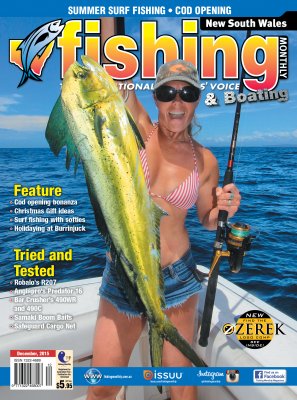Cranking cod on the cast by Wayne Dubois
 Ten or so years ago if one was to talk about a lure angler they would almost instantly think of trollers or anglers trolling lures. Fast forward and sure, trolling is still as popular as ever, but casting lures is now growing in leaps and bounds.
Ten or so years ago if one was to talk about a lure angler they would almost instantly think of trollers or anglers trolling lures. Fast forward and sure, trolling is still as popular as ever, but casting lures is now growing in leaps and bounds.
Gone are the days of casting lures only being for the tournament anglers, just look around on any given weekend in any given impoundment around the country and you will almost definitely see boats actually casting lures rather than just towing them around hoping for a fish.
Magazines, the tournament scene and social media certainly have helped push the types of info anglers needed to become successful lure casters. Once anglers realised that not only is it just as easy as trolling, but it is more fun and most importantly, casting lures is often much more successful. The reason for this is the ability to continue to target the one snag or fish repeatedly and much quicker than you could by trolling, thereby annoying the fish to strike at your lure whether the fish is hungry or not.
The strike from a Murray cod whilst casting and retrieving lures can be bone jarring and often scare the hell out of you. Anyone who has experienced this before will tell you that once you feel that first strike from a big Murray cod, just like the rest of us, you will have been converted to this casting game and will be addicted for life.
If you're new to the world of Murray cod I will now run you through what types of areas to look for when casting lures, what lures to use in what areas and the best retrieve styles to help you all have more success when casting lures for these great fish.
TARGET AREAS
Murray cod live on and ambush their prey from structure and the obvious places are any form of drowned tree both standing, but particularly lay downs. Although these areas are great to target Murray cod, don't disregard other forms of structure like rock walls or points and shallow weedy bays when fishing the lakes or back eddies in faster flowing creeks and rivers. In low light conditions cod will often leave the safety of their home and venture along these rock walls and shallow weedy bays in search of a feed.
LURES
When casting lures to drowned trees it is hard to beat spinnerbaits, angel baits, and large plastics rigged weedless on jigheads matched to the depth.
If the water you are fishing is not too deep, a floating hardbody could be useful as it will enable you to get down into the zone and keep it there for the maximum amount of time. If you feel your lure bump against a snag, simply stop winding and allow the lure to float up and over the snag before recommencing your retrieve.
Alternatively, you can if you dare try a lipless crankbait, fish in these areas don't see this style of lure very often so they tend to work quite well, but they are prone to snagging. When fishing the trees and weed I recommend, rigging your lipless crank baits with a set of swinging, backward facing assist hooks to limit your snags. or try the Insanity Tackle Slap Walkers rigged on the rear tow point. These lipless crankbaits when rigged this way are one of the most snag resistant lipless crankbait on the market.
If you are searching large areas for active fish a good load rattling lipless crankbait is my favourite, but all of the above mentioned lures will work for this type of fishing.
Spinnerbaits are by far the most dominant cod lure on the market, and in dirty water, I only use double Colorado's set ups. They're also effective when targeting really big fish.
RETRIEVE STYLES
Slow retrieve/
This is probably the most consistent cod catching retrieve. Simply cast your lure out and once your lure is in the zone simply start slow rolling the lure back and often the slower the better with this retrieve style.
Slow retrieve with pauses
This retrieve is commonly used when fishing from a boat and is exactly the same as the slow retrieve, we just implement pauses during the retrieve to allow the lure to sink down to the desired depth again as most lures will ride up in the water column when retrieved.
Pausing and allowing the lure to sink back to the bottom will keep your lure in the zone for the maximum amount of time. This retrieve is especially handy when fishing deep areas like steep rock walls.
Depending on how deep the water is one or two pauses during the retrieve may be enough but in super deep water that drops off quickly you may need to just do two or three winds then allow the lure to sink again, sometimes up to ten times in one retrieve.